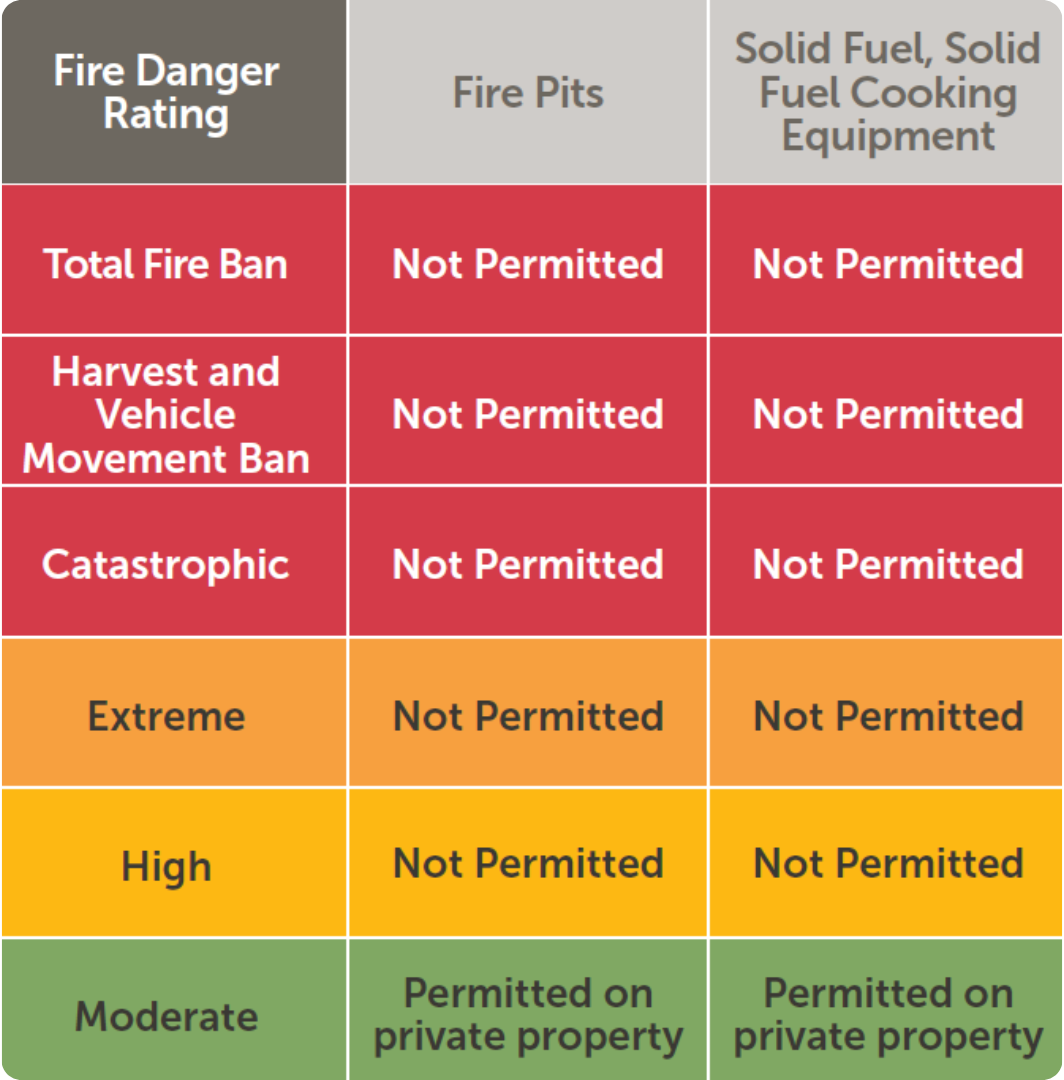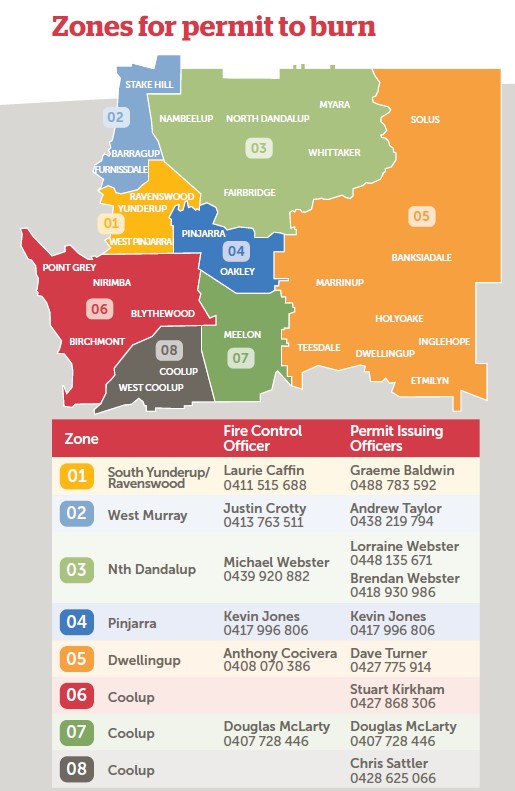Your property
It is too late to prepare your property when a serious fire is threatening.
Fuel loads (flammable material) influence bushfire intensity. If the intensity of the fire is low, then there are more options avaliable to firefighters to suppress the fire.
In order for fire appliances (such as fire trucks) to access your property safely, firebreaks are required to be no less than three metres wide and have no less than four and a half metres vertical clearance. Fire appliances must be able to fit through gates on your property.
The average fire appliance is nine metres long.
Asset Protection Zone (APZ)
Having an APZ gives your property a greater chance of surviving a bushfire. An APZ is the area within 20 metres, measured from any external wall, of any habitable building. The zone is within the boundaries of the lot on which the habitable building is situated.
What is required within an asset protection zone?
- Tree crowns must be a minimum of 10 metres apart and not overhang a dwelling.
- Shrubs and trees should not have dead material within the plant.
- Low trees should be pruned to two metres.
- Fuel loads should be reduced and maintained to a height of less than five centimetres or less than two tonnes per hectare.
- No tall shrubs or trees are to be located within two metres of a building, including windows.
- Fences and sheds must be constructed using non-combustible materials such as Colorbond iron, brick, limestone.
- Sheds or other outbuildings should not contain flammable materials.
- Tall shrubs should not be planted in clumps within three metres of a habitable building.
- Lawns must be kept short and green where possible.
Where an APZ is required as part of an approved Bushfire Attack Level (BAL) assessment, it must be maintained in accordance with the BAL report. A BAL report is required as part of all new planning and/or building licence approvals for habitable buildings constructed in bushfire-prone areas.
Planning approval is not required when implementing an APZ.
Alternatives to burning
There are a range of alternatives to burning waste, which will not harm the environment or cause health problems for you or your neighbours.
- Grass can be slashed, grazed or reduced with herbicide to decrease fuel loads. This may be practical in areas difficult to access or if erosion is a concern.
- Green waste and garden refuse can be disposed of via the two annual Green Waste Verge Collections or at the Corio Road and Dwellingup Waste Transfer Stations. This is free for residential properties receiving a weekly waste service.
- Arrange an onsite mulcher for mulching for large quantities of green waste (branches and tree trunks).
- Turn grass clippings, leaves and twigs into mulch or compost.
Note: Mulch piles should be no larger than five cubic metres to reduce the risk of spontaneous combustion and piles should have a three-metre firebreak surrounding them.
Firebreaks and compliance
A Guide to Constructing and Maintaining Firebreaks
Bushfire Compliance Notice
Firebreak contractors list
Fire Response Vehicle Identifier
A Vehicle Identifier Sticker (VIS) System is in place in Murray to ensure the safe and effective recognition, organisation and coordination of farmer response and private contractor firefighting resources.
The stickers are only available for vehicles and machines that can assist with firefighting operations and will be issued to local personnel by Shire staff.
View the DFES guidelines for operating private equipment at fires here.
Note: VIS do not incorporate forestry industries as they have established processes and procedures in place for the use of their private resources, including equipment standards.
Apply now
Use of Solid Fuel, Fire Pits and Solid Fuel Cooking Equipment
Following Section 33(1) of the Bush Fires Act 1954 and the Shire of Murray Bushfire Compliance Notice, the following establishes the requirements where Solid Fuel, Solid Fuel Cooking Equipment and Fire Pits as defined below are permitted to be used within the Shire of Murray.
- Solid Fuel: Includes charcoal, wood, BBQ pellets, BBQ briquettes and heat beads.
- Solid Fuel Cooking Equipment: Includes BBQs, grills, pizza ovens and smokers.
- Fire Pits: Includes chimeneas, fire baskets and fire bowls.
Unless otherwise stipulated, fully incapsulated gas BBQs can be used at any time of the year.
Campfires and Fire Pits are not permitted on Shire-owned and managed land as noted within the Shire of Murray Consolidated Local Law.
Solid Fuel, Solid Fuel Cooking Equipment and Fire Pits can only be used in accordance with the requirements as stipulated in the table below.

Compliance with the following requirements for the use of Solid Fuel, Solid Fuel Cooking Equipment and Fire Pits must be adhered to:
- The fire must be contained within a non-flammable container.
- The fire must be supervised at all times and must never be left unattended.
- At least 3 metres surrounding the fire must be free of any flammable material.
- The person supervising the fire must have access to an adequate water supply and/or a fire extinguisher sufficient enough to be able to extinguish the fire.
Please Note:
In accordance with the Shire of Murray Health Local Law 2018, it must be ensured that any fire does not emit excessive smoke, which may be an irritation or annoyance to others.
Restricted burning time
- 1 October - 30 November (inclusive)
- 1 April - 15 May (inclusive)
Unseasonal weather conditions may vary these dates. A permit is needed to burn during these times.
Burning is prohibited on days where the Fire Danger Rating is High or above or if a Total Fire Ban (TFB), Harvest Vehicle Movement Ban (HVMB) is declared.
Prior to any burning, you should advise your Permit Issuing Officer and the Department of Fire and Emergency Services' Communication Centre.
Burning garden refuse or rubbish during limited burning times (s.24G of the Act)
For the purposes of this Clause, ‘Limited Burning Time’ means 1 October each calendar year through until 15 May the following calendar year (inclusive, and as varied pursuant to Sections 17 and 18 of the Act).
1. The burning of garden refuse or rubbish is prohibited on all land within the district that is under 4,000m² in size during the Limited Burning Time that would otherwise be permitted under section 24F of the Act.
On land larger than 4,001m² the burning of garden refuse or rubbish that would otherwise be permitted under section 24F is prohibited absolutely during the Prohibited Burning Time.
The effect of this clause is that;
- The burning of garden refuse or rubbish in an incinerator or on the ground on land that is 4,000m² or less in size is prohibited during the Limited Burning Time; and,
- The burning of garden refuse or rubbish in an incinerator or on the ground is prohibited on all land within the district during the Prohibited Burning Time.
2. In addition to the above restrictions, any person burning garden refuse or rubbish on the ground must do so in accordance with the following requirements:
- There is to be no flammable material (other than that being burnt) within 5 metres of the fire at any time while the fire is burning.
- The fire is lit between 6:00pm and 11:00pm and is completely extinguished before midnight on the same day.
- At least one person is present at the site of the fire at all times until it is completely extinguished.
- One pile (up to one cubic metre in size) can only be burnt at a time.
- The person intending to light the fire must telephone the Department of Fire and Emergency Services Communications Centre (COMCEN) immediately prior to igniting, on (08) 9395 9209 or 1800 198 140.
- When the fire is no longer required, the person who has lit the fire must ensure that the fire is completely extinguished by the application of water or earth.
3. Burning garden refuse or rubbish—whether in an incinerator or on the ground—is prohibited on all land within the district whenever any of the following are in effect:
-
A High, Extreme, or Catastrophic fire danger forecast (issued by the WA Bureau of Meteorology)
-
A Total Fire Ban
-
Any other prohibition under the Act
4. The Shire of Murray Health Local Law 2018 further restricts and/or prohibits the burning of rubbish or refuse on land in the district.
Materials that cannot be burnt
Our Health Local Law prohibits the burning of the following materials:
- Plastic
- Rubber
- Food scraps
- Green garden material.
Prohibited burning time
- 1 December - 31 March (inclusive)
Unseasonal weather conditions may vary these dates.
During the Prohibited Burning Time, setting fire to bush is prohibited at all times.
Outdoor cooking during prohibited burning times
- Gas and electric barbeques are allowed.
- Solid fuel barbecues, spit roasts, webers, pizza ovens and other cooking fires are prohibited.
Burning of garden refuse or rubbish during prohibited burning times
This includes incinerators and on the ground and is prohibited.
Camp or Cooking Fires (s.25(1a) of the Act)
The lighting of camp or cooking fires is prohibited on all land within the Shire of Murray during the Prohibited Burning Time. This prohibition does not apply to a gas appliance which does not consume solid fuel comprising of a fire, the flame of which is encapsulated by the appliance.
Fire prevention work
Installed on or before 30 November.
Maintained up to and including 15 May.
Preparing for fires is essential to living in our fire-prone landscape. It is imperative that you prepare your property thoroughly, well before the fire season.
Permit to burn
During Restricted Burning Times, a permit to burn is required.
Check your zone on the map below and contact the relevant Fire Control Officer or locality Permit Issuing Officer.
No fires are to be lit when the Fire Danger Rating is high or above or if a Total Fire Ban, Harvest Ban or Vehicle Movement Ban is declared.

- No permits will be issued during prohibited burning times.
- No permits will be issued for properties less than 4,000sqm.
- Permit holders are required to adhere to all conditions on the permit.
- Special conditions may apply.
Before and during burning
- Weather conditions: Always check with the Bureau of Meteorology for haze alerts and weather conditions in your area.
- Tell your neighbours: Give sufficient notice to allow others to be prepared, especially if they need to relocate anyone with respiratory issues.
- Condition of refuse: Only burn dry, dead material to minimise the amount of smoke produced.
- Control the load: Do not burn more than you can manage – start with a smaller fire and gradually add more material.
Burning on Shire land
Approval is required to burn on Shire land.
Complete the form and send through to mailbag@murray.wa.gov.au for approval.